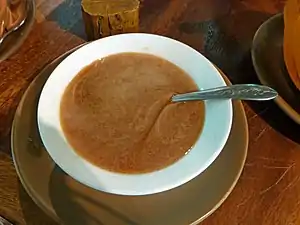Treacle
Treacle (/ˈtriːkəl/)[1] is any uncrystallised syrup made during the refining of sugar.[2][3] The most common forms of treacle are golden syrup, a pale variety, and a darker variety known as black treacle. Black treacle, or molasses, has a distinctively strong, slightly bitter flavour, and a richer colour than golden syrup.[4] Golden syrup treacle is a common sweetener and condiment in British cookery, found in such dishes as treacle tart and treacle sponge pudding.

Etymology
Historically, the Middle English term treacle was used by herbalists and apothecaries to describe a medicine (also called theriac or theriaca), composed of many ingredients, that was used as an antidote for poisons, snakebites, and various other ailments.[3] Triacle comes from the Old French triacle, in turn from (unattested and reconstructed) Vulgar Latin *triacula, which comes from Latin theriaca,[5] the latinisation of the Greek θηριακή (thēriakē), the feminine of θηριακός (thēriakos), 'concerning venomous beasts',[6] which comes from θηρίον (thērion), 'wild animal, beast'.[7][8]
Production
Treacle is made from the syrup that remains after sugar is refined. Raw sugars are first treated in a process called affination. When dissolved, the resulting liquor contains the minimum of dissolved non-sugars to be removed by treatment with activated carbon or bone char. The dark-coloured washings are treated separately, without carbon or bone char. They are boiled to grain (i.e. until sugar crystals precipitate out) in a vacuum pan, forming a low-grade massecuite (boiled mass) which is centrifuged, yielding a brown sugar and a liquid by-product—treacle.[9] Black treacle (molasses) naturally contains relatively high levels of sulphite (>100ppm, expressed in sulphur dioxide equivalent). These levels are deemed safe for the majority of the population, but some allergic and respiratory reactions have been reported particularly amongst asthmatics, such that the United States Food and Drug Administration requires that levels over 10ppm, i.e. >10mg/kg, be declared on the ingredients label.[10]
In culture
A traditional Cornish fisherman's celebratory drink is "Mahogany", made from two parts local gin—now usually Plymouth Gin—mixed with one part black treacle.[11][12][13]
In chapter 7 of Lewis Carroll's Alice's Adventures in Wonderland, the Dormouse tells the story of Elsie, Lacie, and Tillie, who live at the bottom of a well. This confuses Alice, who interrupts to ask what they ate for sustenance. "The Dormouse again took a minute or two to think about it, and then said, 'It was a treacle-well.'" This is an allusion to the so-called "treacle well", the curative St. Margaret's Well at Binsey, Oxfordshire.[14]
History
UK production is almost exclusively from Tate & Lyle. Black treacle - Fowlers and Blackie's both referred to it as treacle (cf Golden Syrup). Tate & Lyle acquired both companies. Treacle (black) before WW2 could be seen served from a barrel and transferred to the customers' container with a 'stick'.
See also
- Caramelisation
- List of syrups
- Treacle mining
- Treacle protein
- Treacle sponge pudding
- Venice treacle, also known as Treacle of Andromachus: see Theriac § Theriaca Andromachi Senioris
References
Citations
- "treacle, n.", in the Oxford English Dictionary, Oxford: Oxford University Press.
- "Treacle Origins and Uses at www.recipes4us.co.uk".
- Oxford Dictionary ISBN 978-1-85152-101-2
- "Definition of TREACLE". www.merriam-webster.com.
- theriacus, Charlton T. Lewis, Charles Short, A Latin Dictionary, on Perseus
- θηριακός, Henry George Liddell, Robert Scott, A Greek–English Lexicon, on Perseus
- θηρίον, Henry George Liddell, Robert Scott, A Greek–English Lexicon, on Perseus
- Treacle, on Oxford Dictionaries
- Heriot p 392
- Bindu Nair and Amy R. Elmore, Final Report on the Safety Assessment of Sodium Sulfite, Potassium Sulfite, Ammonium Sulfite, Sodium Bisulfite, Ammonium Bisulfite, Sodium Metabisulfite and Potassium Metabisulfite, International Journal of Toxicology 22(Suppl. 2):63–88, 2003, page 67,
- "Archived copy". Archived from the original on 2014-12-13. Retrieved 2014-12-13.CS1 maint: archived copy as title (link)
- "Gin Brandy Beer and Treacle". www.theoldfoodie.com.
- "Archived copy". Archived from the original on 2014-12-16. Retrieved 2014-12-13.CS1 maint: archived copy as title (link)
- p14, Oxford in English literature: the making, and undoing, of "the English Athens" (1998), John Dougill, University of Michigan Press, ISBN 0-472-10784-4.
Bibliography
- Heriot, Thomas Hawkins Percy (1920). The manufacture of sugar from the cane and beet. London: Longmans, Green and co.
External links
| Wikimedia Commons has media related to Treacle. |
